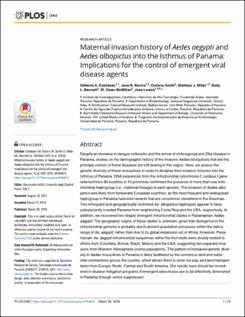| dc.contributor.author | Eskildsen, Gilberto A. | |
| dc.contributor.author | Loaiza, Jose R. | |
| dc.contributor.author | Smith, Octavio | |
| dc.contributor.author | Miller, Matthew J. | |
| dc.contributor.author | Bennet, Kelly L. | |
| dc.contributor.author | McMillan, W. Owen | |
| dc.contributor.author | Rovira, Jose R. | |
| dc.date.accessioned | 2020-07-03T03:04:04Z | |
| dc.date.available | 2020-07-03T03:04:04Z | |
| dc.date.issued | 2018-03-26 | |
| dc.identifier.other | | https://doi.org/10.1371/journal.pone.0194874 | |
| dc.identifier.uri | http://repositorio-indicasat.org.pa/handle/123456789/160 | |
| dc.description | Despite an increase in dengue outbreaks and the arrival of chikungunya and Zika disease in Panama, studies on the demographic history of the invasive Aedes mosquitoes that are the principle vectors of these diseases are still lacking in this region. Here, we assess the genetic diversity of these mosquitoes in order to decipher their invasion histories into the Isthmus of Panama. DNA sequences from the mitochondrial cytochrome C oxidase I gene obtained from 30 localities in 10 provinces confirmed the presence of more than one mitochondrial haplogroup (i.e., maternal lineage) in each species. The invasion of Aedes albopictus was likely from temperate European countries, as the most frequent and widespread haplogroup in Panama harbored variants that are uncommon elsewhere in the Americas. Two infrequent and geographically restricted Ae. albopictus haplotypes appear to have subsequently invaded Panama from neighboring Costa Rica and the USA, respectively. In addition, we recovered two deeply divergent mitochondrial clades in Panamanian Aedes aegypti. The geographic origins of these clades is unknown, given that divergence in the mitochondrial genome is probably due to ancient population processes within the native range of Ae. aegypti, rather than due to its global expansion out of Africa. However, Panamanian Ae. aegypti mitochondrial sequences within the first clade were closely related to others from Colombia, Bolivia, Brazil, Mexico and the USA, suggesting two separate invasions from Western Hemisphere source populations. The pattern of increased genetic diversity in Aedes mosquitoes in Panama is likely facilitated by the numerous land and water inter-connections across the country, which allows them to enter via sea- and land-transportation from Europe, North, Central and South America. Our results here should be considered in disease mitigation programs if emergent arboviruses are to be effectively diminished in Panama through vector suppression. | en_US |
| dc.description.abstract | Despite an increase in dengue outbreaks and the arrival of chikungunya and Zika disease in Panama, studies on the demographic history of the invasive Aedes mosquitoes that are the principle vectors of these diseases are still lacking in this region. Here, we assess the genetic diversity of these mosquitoes in order to decipher their invasion histories into the Isthmus of Panama. DNA sequences from the mitochondrial cytochrome C oxidase I gene obtained from 30 localities in 10 provinces confirmed the presence of more than one mitochondrial haplogroup (i.e., maternal lineage) in each species. The invasion of Aedes albopictus was likely from temperate European countries, as the most frequent and widespread haplogroup in Panama harbored variants that are uncommon elsewhere in the Americas. Two infrequent and geographically restricted Ae. albopictus haplotypes appear to have subsequently invaded Panama from neighboring Costa Rica and the USA, respectively. In addition, we recovered two deeply divergent mitochondrial clades in Panamanian Aedes aegypti. The geographic origins of these clades is unknown, given that divergence in the mitochondrial genome is probably due to ancient population processes within the native range of Ae. aegypti, rather than due to its global expansion out of Africa. However, Panamanian Ae. aegypti mitochondrial sequences within the first clade were closely related to others from Colombia, Bolivia, Brazil, Mexico and the USA, suggesting two separate invasions from Western Hemisphere source populations. The pattern of increased genetic diversity in Aedes mosquitoes in Panama is likely facilitated by the numerous land and water inter-connections across the country, which allows them to enter via sea- and land-transportation from Europe, North, Central and South America. Our results here should be considered in disease mitigation programs if emergent arboviruses are to be effectively diminished in Panama through vector suppression. | en_US |
| dc.language.iso | eng | en_US |
| dc.rights | info:eu-repo/semantics/openAccess | |
| dc.rights | https://creativecommons.org/publicdomain/zero/1.0/ | |
| dc.subject | Maternal invasion history | en_US |
| dc.subject | Aedes aegypti | en_US |
| dc.subject | Aedes albopictus | en_US |
| dc.subject | Panama | en_US |
| dc.subject | emergent viral disease agents | en_US |
| dc.title | Maternal invasion history of Aedes aegypti and Aedes albopictus into the Isthmus of Panama: Implications for the control of emergent viral disease agents | en_US |
| dc.type | info:eu-repo/semantics/article | en_US |
| dc.type | info:eu-repo/semantics/publishedVersion | |

